I am preparing my setup to take to the Lone Star Audio Fest in Dallas next week. Obviously I can't EQ the speakers until I actually get them into the demo room, but I am tweaking my skills to speed the process.
This test was run in a 15'x25'x8' room, untreated but full of furniture. The speakers are A10(M).3's in a MLTL -- the first picture. The speakers are 3' from and centered on the long wall, 8' apart and the microphone 8' back. The speakers are square with the room, so the mic is 30* off axis.
The equipment is USB out of a laptop >>Topping C1 USB/SPDIF translator >> nanoDIGI >> Topping D20 DAC >> Topping TP60 amp. The microphone is a UMM-6.
The red graph is the raw spl before processing. well, not quite. I forgot to save the real raw spl. What I did was set a peak filter of 12dB at 40Hz and then a 48dB high pass filter at 30Hz. Turns out that REW is not happy if the overall spl at cutoff is not higher than the target. Also, I always high pass speakers to protect them from possible very low transients.
Next, I ran the REW room EQ. That produced blue graph. The top end sags because 1) it 30* off axis and 2) farfield is going to tend toward pink noise anyway. So I added a high shelf and tweaked a couple of things and voila -- the black graph.
A couple of interesting things happen with all of this processing. Note that applying room EQ cleaned up the impulse response a lot. This is a good thing. However, all of this processing produced some interesting distortion -- almost all second order. In particular note the 120Hz peak in the final result. All of this added distortion is pretty low frequency, so audibility becomes a question. I didn't go there.
The overall sound is well balanced, but slightly boxy. But then, remember that this is a test of technique rather than a test of sound. The speakers were toed out 30*. 15* would be more appropriate for a final setup.
Bob
This test was run in a 15'x25'x8' room, untreated but full of furniture. The speakers are A10(M).3's in a MLTL -- the first picture. The speakers are 3' from and centered on the long wall, 8' apart and the microphone 8' back. The speakers are square with the room, so the mic is 30* off axis.
The equipment is USB out of a laptop >>Topping C1 USB/SPDIF translator >> nanoDIGI >> Topping D20 DAC >> Topping TP60 amp. The microphone is a UMM-6.
The red graph is the raw spl before processing. well, not quite. I forgot to save the real raw spl. What I did was set a peak filter of 12dB at 40Hz and then a 48dB high pass filter at 30Hz. Turns out that REW is not happy if the overall spl at cutoff is not higher than the target. Also, I always high pass speakers to protect them from possible very low transients.
Next, I ran the REW room EQ. That produced blue graph. The top end sags because 1) it 30* off axis and 2) farfield is going to tend toward pink noise anyway. So I added a high shelf and tweaked a couple of things and voila -- the black graph.
A couple of interesting things happen with all of this processing. Note that applying room EQ cleaned up the impulse response a lot. This is a good thing. However, all of this processing produced some interesting distortion -- almost all second order. In particular note the 120Hz peak in the final result. All of this added distortion is pretty low frequency, so audibility becomes a question. I didn't go there.
The overall sound is well balanced, but slightly boxy. But then, remember that this is a test of technique rather than a test of sound. The speakers were toed out 30*. 15* would be more appropriate for a final setup.
Bob
Attachments
-
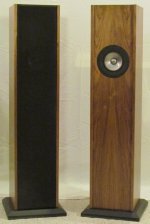 M10-A10.jpg94.1 KB · Views: 263
M10-A10.jpg94.1 KB · Views: 263 -
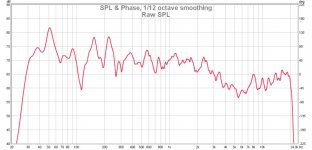 Initial SPL.jpg69.6 KB · Views: 255
Initial SPL.jpg69.6 KB · Views: 255 -
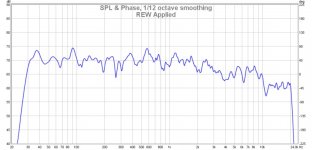 rew applied.jpg67.3 KB · Views: 250
rew applied.jpg67.3 KB · Views: 250 -
 final spl.jpg64.7 KB · Views: 247
final spl.jpg64.7 KB · Views: 247 -
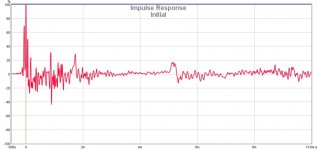 initial impulse.jpg53.5 KB · Views: 244
initial impulse.jpg53.5 KB · Views: 244 -
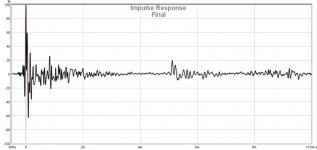 final impulse.jpg49.4 KB · Views: 98
final impulse.jpg49.4 KB · Views: 98 -
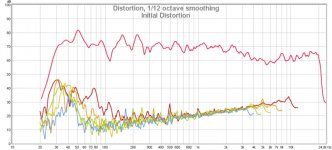 initial distortion.jpg82.9 KB · Views: 89
initial distortion.jpg82.9 KB · Views: 89 -
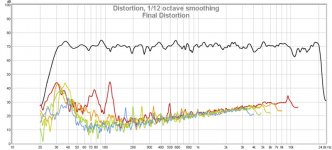 final distortion.jpg79.7 KB · Views: 96
final distortion.jpg79.7 KB · Views: 96
I think you need to limit the maximum gain permitted by the auto EQ feature. The dip at 120 hz is a black hole that cannot be compensated for electronically.
I found that a limit of 3 db was about as much as I could afford without sonic detriment.
I found that a limit of 3 db was about as much as I could afford without sonic detriment.
It's "max individual boost"
http://3.bp.blogspot.com/-JVDeB0vpL...U/w6xNG9zJNA4/s1600/match+target+response.JPG
The MA10.3 has solid output down to 30HZ? Wow that's pretty good.
http://3.bp.blogspot.com/-JVDeB0vpL...U/w6xNG9zJNA4/s1600/match+target+response.JPG
The MA10.3 has solid output down to 30HZ? Wow that's pretty good.
Last edited:
30Hz with care and no great spl. I design stand-alone single-driver speakers to get to 40Hz. That's enough to cover the string bass and 4-string bass guitar. I may just up the high pass to 40Hz since there really isn't much to gain except distortion in that last 10Hz. Now my 2-way speakers have 12" sealed subs driven by 500w/ch and are flat to 20Hz @ 100dB. That's REAL bass. The tops are full-rangers XO'd at ~200Hz.
Bob
Bob
Try to compare results with the same point and setup but with Fuzzmeasure?
I found some differences even with maverick OSX and predecessor...
.
But seems You have excellent results (for me...) 🙂
I found some differences even with maverick OSX and predecessor...
.
But seems You have excellent results (for me...) 🙂
It's interesting that the HD floor has an upward tilt with high frequency. I wonder why that is? I usually see a flat behavior and a tilt as it goes lower in frequency because of greater excursion. Nice bass extension to 30 Hz though.
Nice post Joseph. My thoughts exactly.
Bob, do you find the HF shelf makes them a bit bright sounding? Or was this a nearfield measurement. I might have misunderstood, but if that's a LP measurement, I'd think a sloping response might sound more natural. Personally, I avoid eq above 500hz unless I'm eq'ing the native response flat. Which might be what you've done here if those are 1m measurements.
Bob, do you find the HF shelf makes them a bit bright sounding? Or was this a nearfield measurement. I might have misunderstood, but if that's a LP measurement, I'd think a sloping response might sound more natural. Personally, I avoid eq above 500hz unless I'm eq'ing the native response flat. Which might be what you've done here if those are 1m measurements.
It's interesting that the HD floor has an upward tilt with high frequency. I wonder why that is? I usually see a flat behavior and a tilt as it goes lower in frequency because of greater excursion. Nice bass extension to 30 Hz though.
I am new to HD plots from REW. Woofer Tester Pro gives this plot, albeit without any EQ:

The tilt up could be due to the high shelf applied to the present case. Also the plot here is at 0.5m while the plot in post #1 is at 2.5m
Bob
Last edited:
That reminds me of of what blueberry hill did.
BLUEBERRY HILL AUDIO | Manufacturer of high-end cables | Products Stereo Systems | Rhapsody in 4D
I didn't think a high mass subwoofer could keep up with a fullrange but after hearing the rhapsody at taves I'm a convert.
The whole thing about high mass woofers and slow bass in utter nonsense. I am not going to run the RSS315HF-4 above 250Hz or so, but I bet it could run successfully with a small mid-tweet as high as 500Hz or so. The issue, as always with big drivers mated with small drivers is uneven polar response at the XO.
Bob
Bob
- Status
- Not open for further replies.
- Home
- Loudspeakers
- Full Range
- Playing with REW
